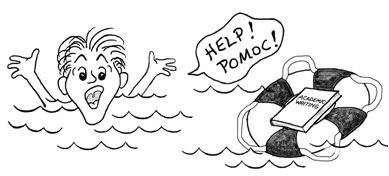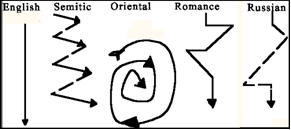Section outline
-
Rozvoj ľudských zdrojov a zabezpečenie kvality na SPU v Nitre
2.1. Rozvoj a prehĺbenie cudzojazyčných kompetencií modernými prístupmi a technológiamiModerné vzdelávanie pre vedomostnú spoločnosť/Projekt je spolufinancovaný zo zdrojov EU
This course is based on the textbook by
Carol L. Ruppel and Katerina Veselá
Academic Writing: Writing Research Papers in English for Slovak and Czech Learners
Illustrations: Carol L. Ruppel
Nitra 2010
ISBN 978-80-89477-03-6
Academic writing does not have to be an overwhelming, daunting task. Instead,it can be a satisfying, rewarding journey, even an inspiring challenge.This course is a guide for those who may have studied English for years, but have had little experience with writing or research in English. Many Internet sources are suggested for those who need or want more specific help.
Good luck!

Carol L. Ruppel & Katerina Veselá
-
Introduction
For most students writing a research paper is difficult, partly because it takes critical thinking to analyse and organize other people’s information into a new entity: their personal approach to a topic in their papers. In addition, English writing requires a specific logical flow of information, which is planned into the document before it is written.
According to Kaplan (1966), most students from non-English-speaking cultures speak and write in different patterns which are culturally based. In his landmark article, he presented these five diagrams to illustrate this point. Although there has been much further discussion on cross-cultural communication since this time, the basic general patterns are still widely accepted. Look at the diagrams below. Do you recognize yourself?
 Kaplan, 1966, p.1
Kaplan, 1966, p.1 KAPLAN, R. B. 1966. Cultural Thought Patternsin Inter-Cultural Education. In LanguageLearning, 16, p. 1-20.
-
Part One: Topic Selection
A research paper is based on three stages of activity:
- Topic selection – narrowing the topic to one research question,
- Research – finding information to answer that question,
- Writing the paper – presenting the information you found in logical, clear, concise paragraphs to answer the question.
The first stage is often neglected or poorly done, resulting in weak, underdeveloped papers. Plan to spend time on this section of the course: it will make your paper better and easier to write in the long run!
Before you continue to Part II, make sure that you have
- A topic which has been developed into one specific final research question which you will answer through your research.
- At least one page of possible sources of information for you chosen topic (your research document from Assignment 1).
-
Part Two: Research - Finding Information
Research is basically the search for information, whether it is library research or experimental research: the goal is to answer a research question. If you know how to use the library and the Internet well, you will have an easier time finding the information you need and putting it together in your paper. This chapter will help you find information more efficiently, as well as keep track of it and record sources correctly, so that writing your paper will go more smoothly and quickly.
Part Two Checklist:Before you continue to Part III, make sure that you have
- A Working Bibliography (Assignment 3) with your sources already in the correct format (APA or ISO 690),
- Notes from sources which have the information you need to write your paper (either on your Working Bibliography or a separate document),
- Your outline (Assignment 4) with subtopics and supporting information listed as a plan for presenting the information in your paper.
-
Part Three: Writing Your Paper
In this section, we will review writing paragraphs and the rules for using information from other sources in your writing. The most important skills we will practice are how to cite your sources and how to paraphrase the information to avoid plagiarism.
To draft a well constructed research paper, you must
- present your information in paragraphs,
- lead the reader through your information using strong transitions,
- clearly indicate the sources of your information,
- write an effective introduction and conclusion.
Part Three Checklist:
Your writing process began with developing a research question (Part One) and researching information (Part Two). Part Three reviewed the skills necessary to draft your paper: writing paragraphs, linking your ideas, citing sources, and writing the introduction and conclusion. Before you are finished, reread it to improve its content and check for errors. Use this checklist as a guide for revision.
Content:
- Introduction begins with hook, leads into topic
- Thesis statement clarifies the purpose of the paper
- Proposed content (subtopics) are clear, logical
- Sufficient supporting evidence from sources
- Strong conclusion; evidence of creative thinking
- Use of visuals is appropriate, explained, or omitted
Organization:
- Clear use of transitions, key words, etc.; paper’s content flows well
- Logical progression of ideas through the whole paper
- Stays on topic, does not have “filler” information
Mechanics:
- Few errors in grammar, verb tenses, punctuation
- Correct manuscript preparation (title page, abstract, etc.)
Research:
- Correctly formatted Reference list, in-text citations
- Source information is integrated together in text
- Variety of in-text citations are used
-
Part Four: Grrrr-ammar!
Grammar is definitely not the most favourite area of any language. Rules, exceptions, mistakes, errors, never ending corrections by teachers… simply discouraging. However, the grammar used in academic writing is not so difficult. Basically, if you are in an academic writing class, your level of English should enable you to deal with what you need to do. However, in this section you can find a review of some basic grammar issues that are necessary for correct writing. If you feel that it is not enough for you and you need more, find a grammar book and/or online resources to practise.
Remember, grammarphobia is treatable — the best cure for it is motivation. In this case, the motivation could be
“I’m bright enough to learn it.”

-
Final Paper
Congratulation! You are ready to submit your final paper now!